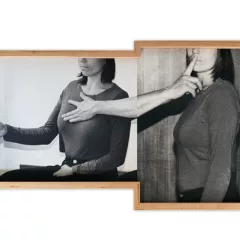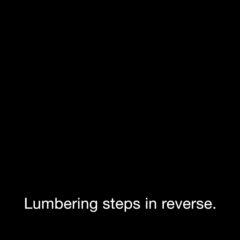[My review of the clay exhibit Dirt on Delight at the ICA was written for Ceramics Monthly, and appears in the March 2009 issue. This is part one of two parts. Roberta also wrote a Weekly Update on the show].
The bitter cold didn’t deter the more than 600 people who attended the opening of a major clay exhibit at the Philadelphia Institute of Contemporary Art. The exhibit, “Dirt on Delight: Impulses that Form Clay” is worth braving the elements–a chance to view a stunning variety of contemporary clay sculptures and some earlier clay sculpture that influenced the more recent works.
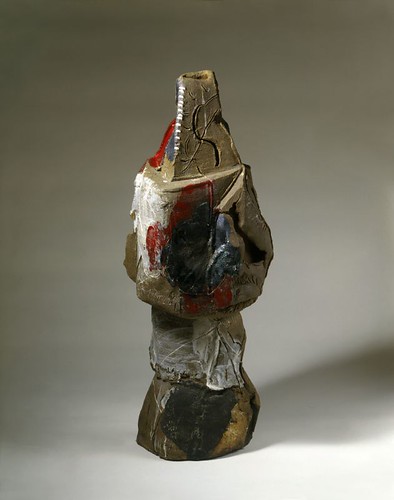
Peter Voulkos, Red River, 1959, stoneware with slip, glaze and epoxy paint, gas fired, 37 x 12-1/2 x 14-1/2 in. Photo: © schoppleinstudio.com. Courtesy of the Voulkos & Co. Catalogue Project, www.voulkos.com
Using historical and groundbreaking clay artists like George Ohr, Viola Frey and Peter Voulkos as a baseline, the show of 22 artists presents an art-historical context for contemporary American clay art. At the same time, the exhibit highlights how the material qualities of clay–its dirt qualities and its delight qualities–are engines for expressing complex ideas and concerns, especially ones about what it means to be human.
At this moment when contemporary art often equals un-beautiful, the ICA is declaring that the art world is ready for a hot embrace of clay’s glorious earthiness, as well as its malleable surfaces that range from seductive and glamorous to gross and comic—that dichotomy is summed up in the exhibit’s title, Dirt on Delight. This show has it all, from Pop to Poop to Popeye.

Ken Price, Zyko, 2008, painted clay and wood pedestal, par 1: 7 x 25.5 x 12 inches, part 2: 8.25 x 25.5 x 15 inches, pedestall 34 inches high, courtesy of the artist and Matthew Marks Gallery
Ken Price’s Zyko is all three, pop, poop and Popeye too. The super-sized pair of twisty, sausages look like a comic book version of a dog pile. Here Price turns clay’s fundamental goopiness into his subject. At the same time he turns his gross matter into a breathtakingly beautiful object. The smooth perfection of the surface delights with its intricate network of glowing colors, the result of Price sanding down the pebbly clay to reveal the multi-colored layers of paint with which he coats his pieces. Zyko embraces the Pop art strategies of bigger, more graphic, slicker and brighter, while implicitly comparing two methods of production–excretion and making art.
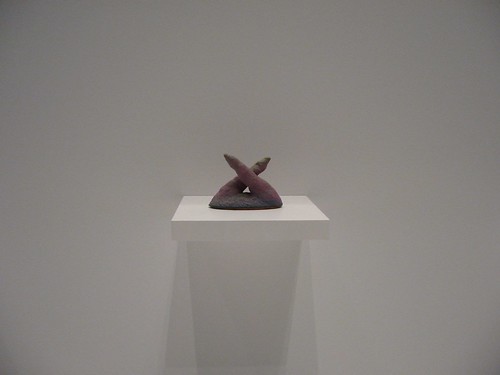
Ron Nagle, Thataway, 1999, earthenware and overglaze, 3.5 inches high, collection Garth Clark and Mark Del Vecchio
In contrast, Ron Nagle’s Thataway is realistically scaled–two delicately colored fingers of dog droppings pointing in opposite directions. Only the formalism and the color separate it visually from its inspiration. Thataway, like Zyko, is comical, but in a different way. The joke is on the doting owner of the beloved dog, a worshipped creature who lowly bodily functions are enshrined here.
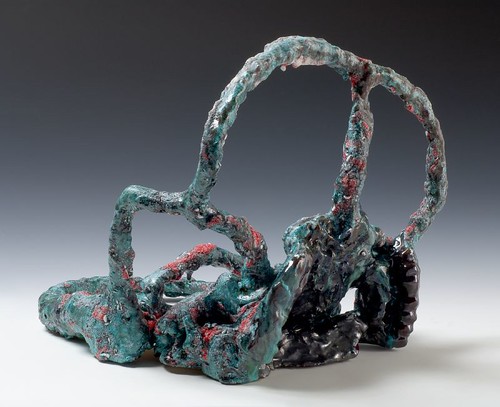
Sterling Ruby, Blue Angel, 2007, glazed ceramic and Formica pedestal, sculpture 17 x 15 x 21 inches, courtesy the artist and Marc Foxx
“Why clay?” asked ICA Senior Curator Ingrid Schaffner at the opening, (The show has three curators, Schaffner, Glenn Adamson of London’s Victoria and Albert Museum, and ICA Assistant Curator Jenelle Porter). “It’s primal,” Schaffner said. “It asks you to touch it.” Prior to firing, it has both scatological and mud-pie making associations. Then Porter chimed in with some commentary on the clean side of clay–its delights: “Even when it’s fired and hard, you still want to touch it,” she said. Other delights include its ornamental glazes, paints, lustres, gilding, piling-on-ness, and playfulness.
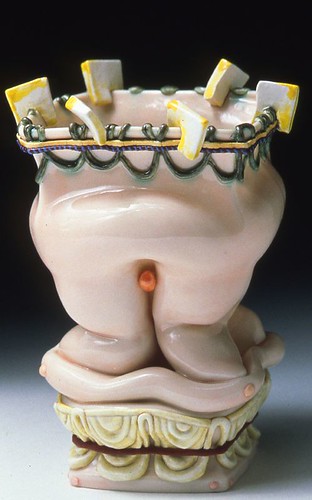
Kathy Butterly, Like Butter, 1997, porcelain, earthenware and glaze, 4.75 x 3.25 x 3 3/8 inches, Love the Saturday Night Live reference! courtesy artist and Tibor de Nagy Gallery.
Kathy Butterly, one of 10 female artists in the exhibit, uses clay’s playful qualities to confront serious issues. Like Butter is four pink, chubby baby legs forming a vessel shape, with tiny tiny red genitals. “It was about falling in love and having a baby,” said Butterly. Her forlorn comicbook figure Fall Into Spring, she said, is about being overwhelmed by too much information following the 9/11 attacks.
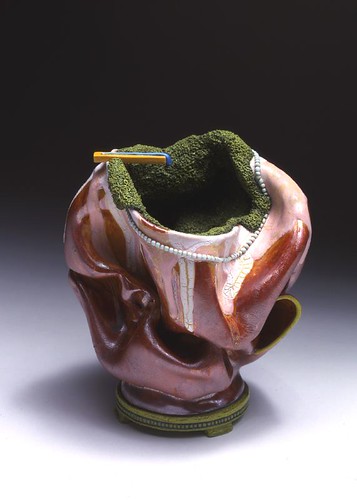
Kathy Butterly, Cenote, 2004, porcelain, earthenware and glaze, 4.75 x 4 1/8 x 4 inches,
private collection courtesy Tibor de Nagy Gallery
Butterly consistently exploits one of the marvels of clay–its ability to express bodily concerns. Cenote is a small landscape of a pot, with droopy pink folds and a tiny pearl necklace just below its mossy green throat. How wonderful that it’s placed near George Ohr’s Small Bowl (c. 1895 to 1900). Small Bowl is demure and old-fashioned, its pink glaze embellished with a pattern. But the softly folded top is shockingly suggestive, as if Ohr had turned his lady upside down to look underneath the patterned skirt! This is the 21st century, so there’s no shock in Butterly’s cup. Rather, the lady is in charge. The pink body here is naked and seductive, the pearls a bold come-hither statement.
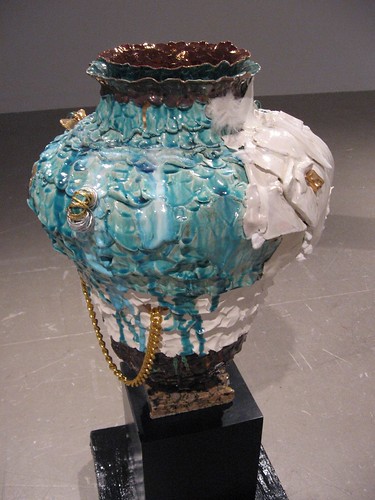
Nicole Cherubini, G-Pot with Rocks, 2006, earthenware, glaze, fake gold and silver jewelry, chain, feathers, luster, white ice, marble, wood, foam and acrylic medium, approx. 28 x 28 x 63 inches; there is also a pom-pom of feathers inside the throat of the vase–not to mention a hole in the bottom (ahem). collection of Barbara Goldfarb
Sex is big in this show, from Nicole Cherubini’s bottomless and punning G-Pot with Rocks, gussied up with golden chains, and with feathers that recollect Meret Oppenheim’s fur-lined teacup; …
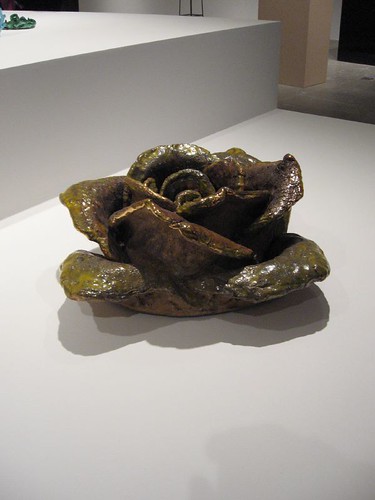
Robert Arneson, Gold Lustred Rose, 1966, glazed ceramic, 29 x 24 x 11 inches, George Adams Gallery and Brian Gross Fine Art
…to Robert Arneson’s Freudian, monumental pieces, Gold Lustred Rose…
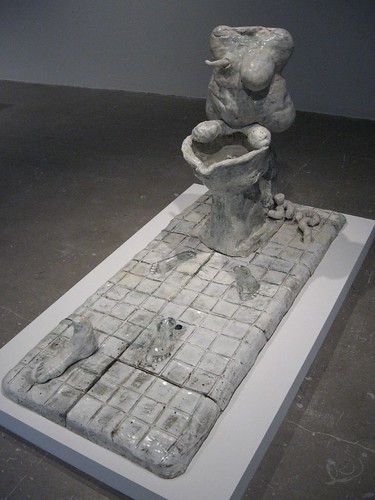
Robert Arneson, John Figure, 1965, glazed stoneware, 35 x 60.5 x 28 inches
…and John Figure—the latter a life-sized toilet bowl with a female torso for a tank, one breast the flusher handle. (Arneson learned his ceramics skills from Ceramics Monthly’s “how to” column, according to the biographical notes provided by the ICA)!
[Part 2 of this post coming soon.]



